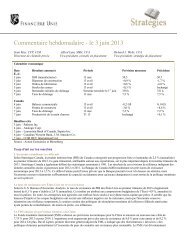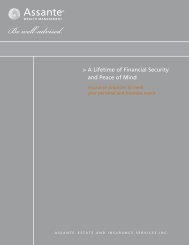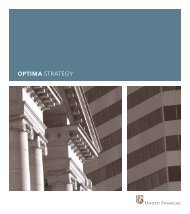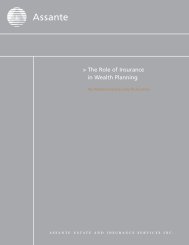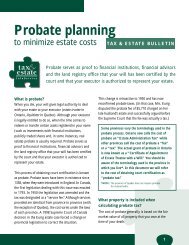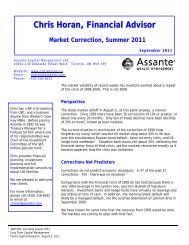FALL 2011 NEWSLETTER - Assante Wealth Management
FALL 2011 NEWSLETTER - Assante Wealth Management
FALL 2011 NEWSLETTER - Assante Wealth Management
Create successful ePaper yourself
Turn your PDF publications into a flip-book with our unique Google optimized e-Paper software.
Page 2<br />
(Continued from page 1)<br />
month or even longer. Extreme market volatility<br />
reminds us that equities are best suited as long-term<br />
holdings, rather than as short-term investments. It's<br />
also important to remember that annual returns from<br />
equities - and growth in corporate earnings - have<br />
historically averaged approximately 6% to 8% over<br />
the long term, but they fluctuate from year to<br />
year. Equity prices over the short term are linked not<br />
just to corporate earnings but also to investors'<br />
emotions. When negativity dominates the news, as it<br />
does today, investors become less willing to buy<br />
equities, and this pushes equity prices lower. And<br />
when the news is positive, investors are optimistic and<br />
equity prices are pushed higher. Remember that when<br />
everyone is discouraged and fearful, risk in the market<br />
is substantially reduced and the opportunity might<br />
be greater. That's because when people are negative,<br />
most of the selling has been done and the bad news is<br />
largely factored into security prices. A bearish<br />
consensus is a prerequisite for a market bottom and<br />
sets the stage for above-average returns on the way<br />
back up.<br />
I N V E STING DURING VOLATILE TIMES<br />
Achieving our retirement income goals requires us to<br />
invest in ways that get us higher returns than those<br />
paid by GICs and government bonds. However,<br />
alongside higher returns also comes higher<br />
volatility. With today's 5 year GICs and 10 year<br />
government bonds paying only 2.5% in annual<br />
interest, this return is not enough to meet our<br />
accumulation goals when saving for retirement nor is<br />
it sufficient to meet our income needs in<br />
retirement. The only thing more painful than<br />
watching your savings decline 10 per cent is realizing<br />
how much more money you will have to save for<br />
retirement if you are unwilling to take on any equity<br />
market risk.<br />
Market volatility affects us in different ways<br />
depending on where we are in our lifecycle.<br />
For those saving for retirement depressed markets<br />
offer the opportunity of buying assets cheap and<br />
watching them rise in value over time.<br />
For those nearing retirement or in retirement<br />
market volatility can play havoc with our<br />
retirement income. A market downturn in the 10 -<br />
15 years before retirement or in the early years of<br />
retirement may force you to reduce your<br />
retirement income or run the risk of outliving your<br />
savings.<br />
While we expect market volatility to continue, we<br />
believe that the guaranteed retirement income<br />
solutions that we offer such as Manulife Income Plus,<br />
SunLife Sunwise Essentials and Canada Life<br />
Lifetime Income Benefit are excellent ways to insure<br />
that your retirement income is not adversely affected<br />
by market downturns yet allows you to receive a pay<br />
increase if markets appreciate. It's a "heads you win,<br />
tails you don't lose" proposition. We have promoted<br />
these guaranteed retirement income solutions in our<br />
newsletter and in our client meetings since the Spring<br />
of 2008 and they have proven themselves to be<br />
excellent solutions.<br />
Y OUR PORT F O L I O EAR NS<br />
D I V I DENDS AND INTEREST<br />
The government and corporate bonds as well as the dividend paying<br />
equities that are in your portfolio pay you dividends and interest each<br />
year which accumulate on a tax deferred basis in your RRSP, TFSA<br />
and RESP. The yield on a balanced portfolio, not counting capital<br />
gains, is generally in the range of 3% annually which is actually more<br />
than today's approximate 2.5% rate on a five year GIC.



